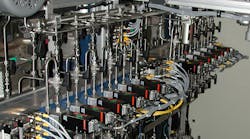Most mass flow controllers employ a thermal principle, but they are not thermal-dispersion flowmeters. Instead, they measure flow by means of a capillary tube. While thermal meters pass all of the fluid through the meter body, MFCs divert some of the fluid through a small capillary tube. This fluid is diverted by creating a small pressure drop in the flow line, which can be done with a laminar flow element. The diverted fluid travels in an inverted U shape until it rejoins the main flowstream.
At the top of the inverted U, two resistance temperature detectors (RTDs) are wrapped around the outside of the capillary tube. Both RTDs are heated. In a condition of no flow, both RTDs have the same signal across them. As flow occurs through the tube, heat is transferred from the upstream RTD to the downstream RTD. This creates a temperature differential between the two RTDs that is proportional to flowrate. The flowmeter electronics sense the difference in signals between the two RTDs, which it uses to create an output signal.
In many ways, the history of mass flow controllers parallels that of thermal flowmeters. Hastings introduced a “thermal air probe” in 1955, which contained small thermocouples in the flowstream. The thermocouples measured the rate of cooling. This device became covered with grime and could not tolerate the heat. As a result, it had to be withdrawn from the market.
Hastings tried again with a capillary tube design, but instead of putting the probe into the flare stack, they put it into a capillary tube that had the temperature sensors on the outside. This was very similar to the design that a mass flow controller uses today to measure flow. When the tube became plugged, it was cleared out with a source of air. This new device was more successful than the earlier version.
One important development that is occurring in the mass flow controller market is that a number of companies that supply the semiconductor market are now looking also at industrial applications. The semiconductor market has always been the larger of the two markets, and still is, but it is also notorious for its up and down cycles.
MFC companies who expand into industrial markets can help compensate for the cyclical nature of the semiconductor market with applications that are less subject to fluctuation.
Some of the industrial areas that hold promise for mass flow controllers include: Chemical; Biotech; Pharmaceutical; Solar/Photovoltaic; Fuel Cells; Metals Processing; and LED Lighting.
Jesse Yoder, Ph.D., is president of Flow Research Inc. in Wakefield, Mass., a company he founded in 1998. He has 25 years of experience as an analyst and writer in process control. Dr. Yoder specializes in flowmeters and other field devices, including pressure and temperature products. Dr. Yoder can be reached at [email protected].
For more information on Flow Research’s work in the area of mass flow controllers, visit FlowMFC.com.



